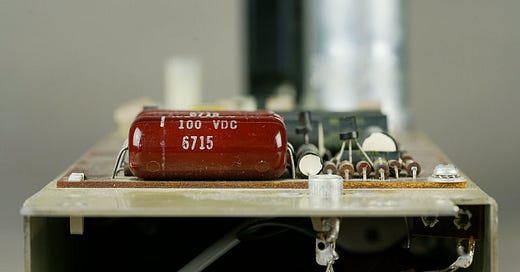Troubleshooting Wurlitzer amplifiers using the phono input
Are phono inputs still useful? Yes, but probably not for the reasons Wurlitzer intended
Today, everyone wants an output on their Wurlitzer amplifier. Outputs are extremely useful: for recording, for inserting effects, for connecting the piano signal to a newer, cooler amplifier. It doesn’t even matter if we ever use the output for any of those things. It’s like booking the hotel with the pool for a one-night getaway. The important thing isn’t whether you bothered to use the pool, it’s that you could have, if the inspiration struck.
Inputs, though, are not useful. We all have more inputs than we know what to do with: tube amplifiers, solid state amplifiers, bluetooth speakers, speaker cabinets, smartphones, smart TVs, laptops, AirPlay, aux cables, etc. If we have an input signal that we want to hear, we have the devices to make it happen. Basically, there is not a single circumstance where we would have to resort to plugging anything at all into the RCA phono input jack of a Wurlitzer 140a or 140b.
Of course, in the 1960s, times were different, and extraneous inputs were very useful. If you wanted to hear a song, you couldn’t just pull it up on Spotify. You had to connect your record player to some sort of amplifier, which nobody had yet figured out how to fit into the palm of your hand. A Wurlitzer electronic piano didn’t have room for a lot of extra bells and whistles, but it did have an amplifier and a spare square inch for mounting an RCA jack.
So, the Wurlitzer phono inputs are just a relic of ancient technology, completely useless for all contemporary purposes? No. The phono inputs are actually invaluable for troubleshooting broken amplifiers. They provide a quick-and-dirty test point for determining where a signal is interrupted—no oscilloscope required.
TROUBLESHOOTING 140A AND 140B AMPLIFIERS USING THE PHONO INPUT
The phono input is very convenient for troubleshooting a 140a or 140b amplifier that is not passing signal, has low volume, or other issues. (This technique can also be used in a similar way for tube amplifiers. For me, personally, I restore Wurlitzer tube amplifiers by removing all components. So, if I’m using this technique, I’m probably working on a 140a or 140b, and this article will reflect that.)
There are two common failure points on 140a and 140b Wurlitzer amplifiers: the electrolytic capacitors, and the germanium power transistors.
The particular kind of black and white electrolytics used in the 140b have not aged well. Many of them have failed, and will no longer pass signal.
The germanium power transistors are hot, old, and directly coupled to the speaker output. They are susceptible to output mishaps—which may arise, for instance, when hot-plugging devices into the aux speaker and headphone jacks (a temptation since the 140b does not have an official preamp output).
Of course, the small-signal transistors, resistors, and other styles of capacitors might also malfunction. It is also possible for cold solder joints and loose connections to interrupt signal and introduce noise.
Considering all of the possible ways an amp can fail, it is much easier to troubleshoot if we can isolate the issue to a small portion of the circuit. We can do this by taking an output from different parts of the preamp, and sending it to an external amplifier. Based on whether we hear signal from that output, we can draw inferences about which parts of the circuit are working, and which parts are not.



